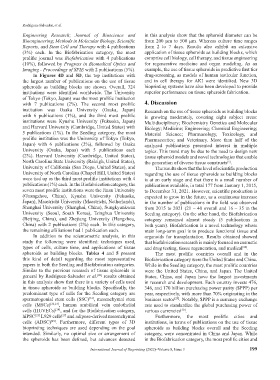Page 207 - IJB-8-3
P. 207
Rodriguez-Salvador, et al.
Engineering Research; Journal of Bioscience and in this analysis show that the spheroid diameter can be
Bioengineering; Methods in Molecular Biology, Scientific from 200 µm to 500 µm. Whereas culture time ranges
Reports, and Stem Cell and Therapy with 4 publications from 2 to 7 days. Results also exhibit an extensive
(3%) each. In the Biofabrication category, the most application of tissue spheroids as building blocks, which
prolific journal was Biofabrication with 4 publications comprise cell biology, cell therapy, and tissue engineering
(10%), followed by Progress in Biomedical Optics and for regenerative medicine and organ modeling. As an
Imaging - Proceedings of SPIE with 2 publications (5%). example, the use of tissue spheroids in predictive first tier
In Figures 4D and 5D, the top institutions with drug-screening, as models of human testicular function,
the largest number of publications on the use of tissue and in cell therapy for AKI were identified. New 3D
spheroids as building blocks are shown. Overall, 324 bioprinting systems have also been developed to provide
institutions were identified worldwide. The University superior performance on tissue spheroids fabrication.
of Tokyo (Tokyo, Japan) was the most prolific institution
with 7 publications (2%). The second most prolific 4. Discussion
institution was Osaka University (Osaka, Japan) Research on the use of tissue spheroids as building blocks
with 6 publications (1%), and the third most prolific is growing moderately, covering eight subject areas:
institutions were Kyushu University (Fukuoka, Japan) Multidisciplinary; Biochemistry Genetics and Molecular
and Harvard University (Cambridge, United States) with Biology; Medicine; Engineering; Chemical Engineering;
5 publications (1%). In the Seeding category, the most Material Science; Pharmacology, Toxicology, and
prolific institution was the University of Tokyo (Tokyo, Pharmaceutics; and Veterinary. More than half of the
Japan) with 6 publications (2%), followed by Osaka analyzed publications presented interest in multiple
University (Osaka, Japan) with 5 publications each topics. This trend may be due to the need to design new
(2%). Harvard University (Cambridge, United States), tissue spheroid models and novel technologies that enable
North Carolina State University (Raleigh, United States), the generation of diverse tissue constructs .
[5]
University of California (San Diego, United States), and The results show that the level of scientific production
University of North Carolina (Chapel Hill, United States) regarding the use of tissue spheroids as building blocks
were tied up as the third most prolific institutions with 4 is at an early stage and that there is a small number of
publications (1%) each. In the Biofabrication category, the publications available, in total 177 from January 1, 2015,
seven most prolific institutions were the Jinan University to December 31, 2021. However, scientific production is
(Guangzhou, China), Kyushu University (Fukuoka, expected to grow in the future, as a continuous increase
Japan), Maastricht University (Maastricht, Netherlands), in the number of publications in the field was observed
Shanghai University (Shanghai, China), Sungkyunkwan from 2015 to 2021 (21 – 40 overall and 16 – 35 in the
University (Seoul, South Korea), Tsinghua University Seeding category). On the other hand, the Biofabrication
(Beijing, China), and Zhejiang University (Hangzhou, category remained almost steady (5 publications in
China) with 2 publications (2%) each. In this category, both years). Biofabrication is a novel technology whose
the remaining affiliations had 1 publication each. main long-term goal is to produce functional tissue and
In addition to the scientometric analysis, in this organoids for transplantation. Results obtained showed
study the following were identified: techniques used, that biofabrication research is mainly focused on cosmetic
types of cells, culture time, and applications of tissue and drug testing, tissue regeneration, and medical .
[28]
spheroids as building blocks. Tables 4 and 5 present The most prolific countries overall and in the
this kind of detail regarding the most representative Biofabrication category were the United States and China.
papers in both the Seeding and Biofabrication categories. While in the Seeding category, the most prolific countries
Similar to the previous research of tissue spheroids in were the United States, China, and Japan. The United
general by Rodriguez-Salvador et al. results obtained States, China, and Japan have the largest investments
[20]
in this analysis show that there is a variety of cells used in research and development. Each country invests 476,
in tissue spheroids as building blocks. Specifically, the 346, and 170 billion purchasing power parity ($PPP) per
predominant type of cells for the Seeding category are year, respectively, with more than 70% originating in the
spermatogonial stem cells (SSC) , mesenchymal stem business sector . Notably, $PPP is a currency exchange
[33]
[29]
cells (MSCs) [22,23] , human umbilical vein endothelial rate used to standardize the global purchasing power of
cells (HUVECs) , and for the Biofabrication category, various currencies .
[30]
[34]
hiPSC L929 cells and adipose-derived mesenchymal Furthermore, the most prolific cities and
[27]
[25]
cells (ADSC) . Furthermore, different types of 3D institutions, in terms of publications on the use of tissue
[49]
bioprinting techniques are used depending on the goal spheroids as building blocks overall and the Seeding
intended. Similarly, no optimal size or arrangement of category, were concentrated in China and Japan. While
the spheroids has been defined, but advances detected in the Biofabrication category, the most prolific cities and
International Journal of Bioprinting (2022)–Volume 8, Issue 3 199

